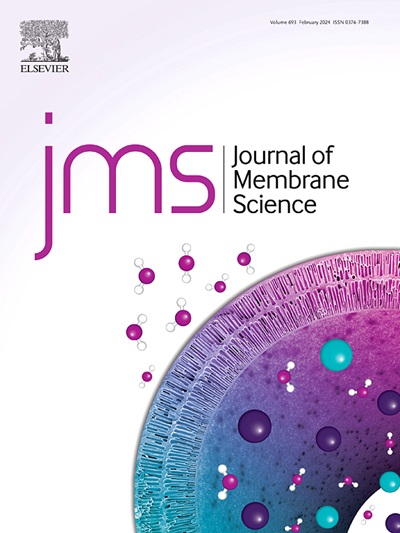Efficient preparation of large-area, high-selective SSZ-13 membrane
IF 9
1区 工程技术
Q1 ENGINEERING, CHEMICAL
引用次数: 0
Abstract
Rub-coating and vacuum assisted dip-coating, are two conventional seeding methods in the preparation of zeolite membranes. Herein, we successfully synthesized SSZ-13 membrane with an effective area of 142.4 cm2 and a length of 40 cm on α-alumina support by combining a vacuum-assisted dip-coating method and a rub-coating method. An investigation was conducted into the effects of five distinct seeding methods on the fabrication of SSZ-13 membranes. A thin, uniform and continuous seed layer was obtained through two distinct seeding methods: vacuum assisted dip-coating followed by rubbing the dried seeded support (referred to as VADC-rub1) and vacuum assisted dip-coating followed by rubbing the seeded support within the dipping solution (referred to as VADC-rub2), and the as-synthesized membranes were dense and uniform with thin membrane thickness (1.3–1.8 μm). Following the division of the 40 cm long SSZ-13 membrane into four 10 cm long SSZ-13 membranes, the characterizations of these membranes were conducted via XRD, SEM. In addition, single-gas permeation and CO2-CH4 mixture separation was performed. CO2 and CH4 had average permeances of (7.80 ± 2.23) × 10−7 mol m−2 s−1·Pa−1, (1.36 ± 0.25) × 10−9 mol m−2 s−1·Pa−1 in equimolar mixture, respectively and CO2-CH4 mixture selectivity was 561 ± 68, further confirming the membranes formed on four different positions of 40-cm-long were uniform, dense and of high-quality, showing their potential for gas separation applications.

大面积高选择性SSZ-13膜的高效制备
摩擦镀膜和真空辅助浸渍镀膜是制备沸石膜常用的两种播种方法。在α-氧化铝载体上,采用真空辅助浸渍法和摩擦镀膜相结合的方法,成功合成了有效面积为142.4 cm2、有效长度为40 cm的SSZ-13膜。研究了五种不同的播种方法对制备SSZ-13膜的影响。通过真空辅助浸渍后摩擦干燥的种子载体(VADC-rub1)和真空辅助浸渍后摩擦浸渍液中的种子载体(VADC-rub2)两种不同的播种方法,获得了薄、均匀、连续的种子层,合成的膜致密均匀,膜厚薄(1.3 ~ 1.8 μm)。将40cm长的SSZ-13膜分成4个10cm长的SSZ-13膜,通过XRD、SEM对这些膜进行表征。此外,还进行了单气体渗透和CO2-CH4混合物分离。CO2和CH4在等摩尔混合物中的平均渗透率分别为(7.80±2.23)× 10−7 mol m−2 s−1·Pa−1和(1.36±0.25)× 10−9 mol m−2 s−1·Pa−1,CO2-CH4混合物的选择性为561±68,进一步证实了在40 cm长的4个不同位置形成的膜均匀、致密和高质量,显示了它们在气体分离方面的应用潜力。
本文章由计算机程序翻译,如有差异,请以英文原文为准。
求助全文
约1分钟内获得全文
求助全文
来源期刊

Journal of Membrane Science
工程技术-高分子科学
CiteScore
17.10
自引率
17.90%
发文量
1031
审稿时长
2.5 months
期刊介绍:
The Journal of Membrane Science is a publication that focuses on membrane systems and is aimed at academic and industrial chemists, chemical engineers, materials scientists, and membranologists. It publishes original research and reviews on various aspects of membrane transport, membrane formation/structure, fouling, module/process design, and processes/applications. The journal primarily focuses on the structure, function, and performance of non-biological membranes but also includes papers that relate to biological membranes. The Journal of Membrane Science publishes Full Text Papers, State-of-the-Art Reviews, Letters to the Editor, and Perspectives.
 求助内容:
求助内容: 应助结果提醒方式:
应助结果提醒方式:


